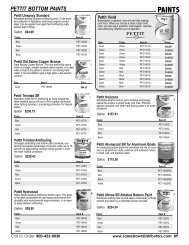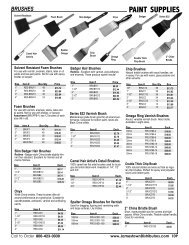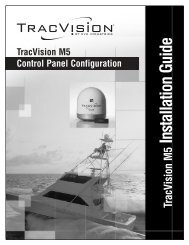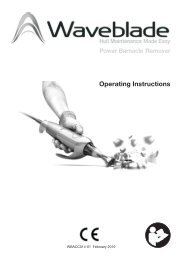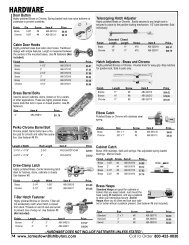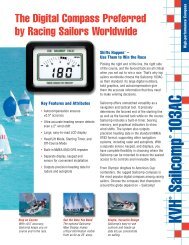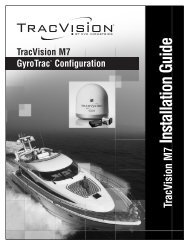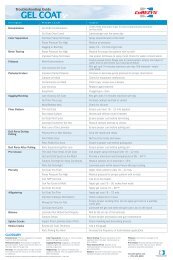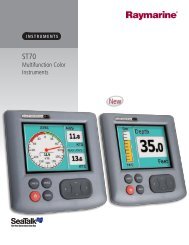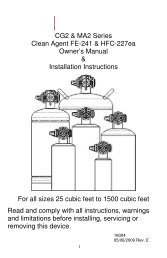Bondo-Hair MSDS Sheet - Jamestown Distributors
Bondo-Hair MSDS Sheet - Jamestown Distributors
Bondo-Hair MSDS Sheet - Jamestown Distributors
You also want an ePaper? Increase the reach of your titles
YUMPU automatically turns print PDFs into web optimized ePapers that Google loves.
MATERIAL SAFETY DATA SHEET<br />
<strong>Bondo</strong>-<strong>Hair</strong>® Long Strand Fiberglass Reinforced Filler<br />
Date of Original Preparation: July 27, 2001 Revision Date: December 16, 2004<br />
Section 1 - Product Information<br />
Manufacturer: <strong>Bondo</strong> Corporation<br />
3700 Atlanta Industrial Parkway NW<br />
Atlanta, GA 30331<br />
Emergency<br />
Telephone:<br />
For US transportation emergencies call -<br />
Chemtrec: 800-424-9300<br />
For Canadian transportation emergencies<br />
call - Canutec: 613-996-6666<br />
Information: 404-696-2730 (USA 8:30am – 4:30pm Eastern Time) Product Use: Body Filler<br />
Stock Number: 762, 764<br />
Emergency Overview<br />
Signs of Overexposure: Nausea, cough, dizziness, weakness, headache, chest pain, lack of coordination, shortness<br />
of breath, dermatitis, redness and/or pain in eyes.<br />
Emergency First Aid: Move to fresh air, remove contaminated clothing, wash effected skin with soap and water, do not<br />
use solvents or thinners; if product gets into eyes, remove contact lenses, flush with water for 15 minutes.<br />
Handling: If handling in a confined space wear an organic vapor cartridge respirator (NIOSH / OSHA). For working,<br />
wear solvent resistant gloves and safety eye protection designed to guard against liquid splashes. Close all containers<br />
tightly after use. Do not eat, drink or smoke in work areas.<br />
Material Physical Appearance: Putty<br />
Other Precautions: Vapors are heavier than air and may travel along floors. Material has an offensive odor.<br />
Prolonged exposure may reduce the user’s sensitivity to the odor, thus reducing the effectiveness of odor as a warning<br />
against exposure.<br />
Fire Fighting: Flammable liquid, refer to Guide 127 of the North American Emergency Guide Book. Forms explosive<br />
mixture with air. Vapors are heavier than air and may travel to a source of ignition and flash back.<br />
NFPA Flammability: IC<br />
<strong>Bondo</strong> Corporation has no oversight with respect to the guidance practices or policies or manufacturing processes of<br />
other companies handling or using this material. The information given in this <strong>MSDS</strong> is only related to the product as<br />
shipped in its original condition as described in Section 2, “Hazardous Ingredients” and Section 9 “Physical and<br />
Chemical Properties”.<br />
Section 2 - Hazardous Ingredients<br />
Percent Vapor ACGIH OSHA LD 50 LD 50 LC 50<br />
Hazardous Ingredient weight CAS No. Press. TLV PEL Oral Derm Inhal LEL<br />
Styrene 15-20% 100-42-5 4.5 20ppm 100ppm 2650 n. av. 12000 1.1<br />
Fibrous Glass 1-10% 65997-17-3 n. ap. 10mg/m 3 15mg/m 3 n. av. n. av. n. av. n.ap<br />
LD 50 Oral - rat mg/m 3 , LD 50 Dermal - rabbit mg/m 3 ,LC 50 Inhalation - rat mg/m 3 unless otherwise specified.<br />
Section 3 – Hazards Identification<br />
Primary Routes of Entry: Inhalation, skin contact, ingestion, eyes.<br />
Exposure Effects Acute and Chronic:<br />
Inhalation: Acute: Nasal and respiratory irritation, nausea, cough, shortness of breath, dehydration, allergic respiratory<br />
reaction, tiredness, dizziness, weakness, headache, anesthesia, drowsiness, fatigue, chest pain, vomiting, central<br />
nervous system effects, narcosis. Liquid can be fatal if aspirated into the lungs.<br />
Skin contact: Acute: Extraction of natural oils with resulting dry skin, irritation, allergic skin reactions, redness and<br />
dermatitis. May be absorbed through the skin.<br />
Eye contact: Acute: Irritation, redness, pain, tearing, blurred vision, sensation of seeing halos around lights and<br />
reversible damage.<br />
Ingestion: Acute: Gastrointestinal irritation, nausea, vomiting, diarrhea, weakness, headache, dizziness, drowsiness,<br />
fatigue, lack of coordination, central nervous system effects, depression.<br />
Chronic: Repeated overexposure to this product may cause: central nervous system damage, hearing damage, kidney<br />
damage, liver abnormalities, lung damage, cardiac abnormalities, reproductive organ damage, blood effects, eye<br />
damage.<br />
Other Health Effects:<br />
Intentional misuse by deliberately concentrating and inhaling the contents may be harmful or fatal. Reports have<br />
associated repeated and prolonged occupational overexposure to solvents with permanent brain and nervous system<br />
damage.<br />
Section 4 – First Aid Measures<br />
Emergency and First Aid Procedures: In all cases if symptoms persist, seek medical attention.
Inhalation - move to fresh air, give artificial respiration if necessary.<br />
Skin contact - remove contaminated clothing, wash with soap and water or recognized skin cleaner. Do not use<br />
solvents or thinners.<br />
Eye contact - contact lenses must be removed, flush with water for at least 15 minutes, consult a physician<br />
immediately.<br />
Ingestion - drink one or two glasses of water to dilute. Do not induce vomiting. Consult a physician or poison control<br />
center immediately. Treat symptomatically<br />
Medical Conditions Prone to Aggravation: pulmonary conditions, skin disorders, liver conditions, kidney conditions,<br />
neurological disorders, pregnancy.<br />
Section 5 – Fire Fighting Measures<br />
Flash Point (SFCC): 82F (28C)<br />
Lower Explosive Limit: 1.1<br />
NFPA Flammability: I C<br />
Extinguishing Media: foam, carbon dioxide, dry chemical or water fog or spray. Water jet or stream is unsuitable.<br />
Unusual Fire and Explosion Hazards: Invisible vapors may travel to source of ignition and flash back. Since vapors<br />
are heavier than air, dangerous concentrations may not be apparent to casual observation. Keep containers tightly<br />
closed, isolate from heat, electrical equipment, sparks and open flame. Closed containers may explode when exposed<br />
to extreme heat. Fire will produce dense black smoke containing hazardous products of combustion. Symptoms may<br />
not be immediately apparent. Obtain medical attention. This product may polymerize when its container is exposed to<br />
heat causing an increase in pressure resulting in a violent rupture.<br />
Special Fire Fighting Procedures: Water should be used to cool containers exposed to fire. Fire fighting personnel<br />
should wear self-contained breathing apparatus.<br />
Section 6 – Accidental Release<br />
Steps To Be Taken In Case Material Is Released Or Spilled: Remove all sources of ignition. Avoid breathing vapors,<br />
ventilate confined area. Dike to reduce extent of spill. Remove with inert absorbent using non-sparking tools. If<br />
necessary report to applicable government agency.<br />
Section 7 – Handling and Storage<br />
Precautions To Be Taken In Handling And Storing: Minimize contact between the worker and this material. No<br />
smoking. Store containers out of sun and away from heat, sparks, and open flames. Close all containers after each<br />
use. Consult NFPA and local codes for additional storage requirements.<br />
Hygienic Practices: Do not eat, drink or smoke in work areas. Wash hands before eating, smoking, or using the<br />
washroom. Launder clothing before reuse.<br />
Other Precautions: Vapors are heavier than air and may travel along floors. Do not take internally. Observe label<br />
precautions. Keep closures tight and container upright to prevent leakage. The information contained in this safety data<br />
sheet does not constitute the user’s own assessment of workplace risks as required by regulations. Material has an<br />
offensive odor. Prolonged exposure may reduce the user’s sensitivity to the odor, thus reducing the effectiveness of<br />
odor as a warning against exposure.<br />
Section 8 – Exposure Controls<br />
Primary Routes of Entry: Inhalation, skin contact, ingestion, eyes.<br />
Personal Protective Equipment: In cases where no monitoring for airborne contaminants has been carried out,<br />
assume maximum exposure and use antistatic paint suit, goggles, gloves, and air supplied respiratory equipment. All<br />
personal protective equipment should meet NIOSH or OSHA requirements.<br />
Respiratory Protection: When personnel, whether spraying or not, are inside a spray booth, ventilation is unlikely to<br />
be sufficient to control particulates and chemical vapor in all cases. In such cases air supplied respiratory equipment is<br />
recommended until particulate and vapor concentration has fallen below exposure limits. If monitoring demonstrates<br />
levels below TLV or PEL wear a NIOSH/MSHA approved respirator device. See safety equipment supplier for<br />
evaluation and recommendation.<br />
Ventilation: Provide sufficient ventilation to keep vapor concentration below the given TLV and/or PEL.<br />
For baking finishes, exhaust vapors emitted during heating. Remove decomposition products formed during welding or<br />
flame cutting of surfaces coated with this product.<br />
Protective Gloves: Required for prolonged or repeated contact. Use solvent resistant gloves. Barrier creams are not<br />
substitutes for full physical protection. Refer to safety equipment supplier for effective glove recommendations.<br />
Eye Protection: Use safety goggles or face shield designed to protect against splash of liquids when spraying or when<br />
working with open liquids such as during mixing or pouring.<br />
Section 9 – Physical and Chemical Properties<br />
Evaporation Rate: Slower than ether<br />
Vapor Density: Heavier than air<br />
Vapor Pressure: 5.2mm Hg @20C
Weight per Gallon (Specific Grav.): 12.5 (1.5)<br />
Odor and Appearance: pungent organic odor, buff liquid<br />
Freezing point, Coefficient of water/oil distribution ,pH: Not applicable or not available<br />
Section 10 – Stability and Reactivity<br />
Stability: Stable<br />
Incompatibility (materials to avoid): Oxidizers, alkali metals, nitric acid, sodium hydroxide.<br />
Hazardous Polymerization: May occur at temperatures over 150F (65C).<br />
Conditions to Avoid: Heat, open flame, sparks.<br />
Hazardous Combustion Products: Oxides of carbon and nitrogen, various hydrocarbons, fumes.<br />
Section 11 - Toxicological Information<br />
Carcinogenicity (risk of cancer): Styrene is listed by IARC as possibly carcinogenic to humans (Group 2B). The IARC<br />
2B classification is not based on significant new evidence that styrene might be a carcinogen, but on a revised IARC<br />
classification scheme and new data on styrene oxide.<br />
Sensitization (effects of repeated exposure): These products may cause inhalation sensitization to certain individuals.<br />
Teratogenicity (risk of malformation in an unborn fetus): None Known<br />
Reproductive Toxicity (risk of sterility): None Known<br />
Mutagenicity (risk of heritable genetic effects): Styrene has given mixed results in a number of tests.<br />
Threshold Limit Value: None established for this product. For further information, see Section 9 - Hazardous<br />
Ingredients<br />
Section 12 - Ecological Information<br />
General Information: Avoid runoff into ground, storms or sewer which lead into waterways. Water runoff can cause<br />
environmental damage.<br />
Environmental Impact Data (percentage by weight):<br />
Ozone Depleters: none Heavy Metals: None<br />
There are extensive ecological data available on the various components of these products. An adequate<br />
representation of all these data is beyond the scope of this document. Please contact the information phone number<br />
found in Section 1.<br />
Section 13 – Disposal Information<br />
Waste Disposal Method: Dispose of in accordance with federal, state or provincial and local pollution requirements.<br />
Clean preferably with a detergent, avoid the use of solvents. This information applies only to the material as<br />
manufactured; processing, use or contamination may make this information inappropriate, inaccurate or incomplete.<br />
The generator of the waste has the responsibility for proper waste classification, transportation and disposal.<br />
Other Information: When discarded in its supplied form, these products meet the hazard criteria of “ignitability” and<br />
must be considered as hazardous waste D001.<br />
Section 14 – Transportation Information<br />
Ground Shipments: The shipper must be trained and certified to handle hazardous materials in ground transportation.<br />
Proper Shipping Name: Consumer Commodity<br />
Hazard Label: ORM-D<br />
Section 15 - Regulatory Information<br />
OSHA: These products are considered hazardous under the Federal OSHA Hazard Communication Standard.<br />
WHMIS: B2;D1A;D2A<br />
SARA Title III:<br />
Section 302 Extremely Hazardous Substances: None<br />
Section 311 / 312 Hazard Categories: Immediate health, delayed health, fire hazard.<br />
Section 313 Toxic Chemicals: styrene. You may be required to submit this <strong>MSDS</strong> to state and local emergency<br />
response agencies (SERC & LEPC) and to your local fire department. Also, you may be affected by other sections of<br />
this law, depending on the chemicals and amounts that you inventory at your location. To learn more about your<br />
responsibilities, call the EPA Hotline (800) 535-0202<br />
TSCA status: All ingredients are TSCA registered.<br />
Proposition 65: WARNING: This product contains a chemical known to the State of California to cause cancer.<br />
NFPA 704: Health 2, Fire 2, Reactivity 0<br />
Section 16 - Preparation Information<br />
Prepared by <strong>Bondo</strong> Corporation Research and Development Department<br />
Phone: 404-696-2730<br />
Do not handle until the manufacturer’s safety precautions have been read and understood. Regulations require that all<br />
employees be trained on Material Safety Data <strong>Sheet</strong>s for all products with which they come in contact.
While <strong>Bondo</strong> Corporation believes that the data contained herein are accurate and derived from qualified sources, the<br />
data are not to be taken as a warranty or representation for which <strong>Bondo</strong> Corporation assumes legal responsibility.<br />
They are offered solely for your consideration, investigation and verification. Any use of these data and information<br />
must be determined by the user to be in accordance with applicable federal, state, provincial and local laws and<br />
regulations.<br />
MATERIAL SAFETY DATA SHEET<br />
Cream Hardener<br />
Date of Preparation: March 23, 2001<br />
Section 1 - Product Information<br />
Manufacturer: <strong>Bondo</strong> Corporation<br />
3700 Atlanta Industrial Parkway NW<br />
Atlanta, GA 30331<br />
Emergency<br />
Telephone:<br />
For US transportation emergencies call -<br />
Chemtrec: 800-424-9300<br />
For Canadian transportation emergencies<br />
call - Canutec: 613-996-6666<br />
Information: 770-441-8628 (USA 7:30am – 4:30pm Eastern Time) Product Use: Bodyfiller Hardener<br />
Emergency Overview<br />
Signs of Overexposure: Nausea, chest pain, lack of coordination, shortness of breath, dermatitis, redness and/or pain<br />
in eyes.<br />
Emergency First Aid: Move to fresh air, remove contaminated clothing, wash effected skin with soap and water, do not<br />
use solvents or thinners; if product gets into eyes, remove contact lenses, flush with water for 15 minutes.<br />
Handling: In confined areas, wear an organic vapor cartridge respirator (NIOSH / OSHA), solvent resistant gloves and<br />
safety eye protection. Do not eat, drink or smoke in work areas.<br />
Material Appearance: Blue<br />
Material Physical Appearance: Paste<br />
Other Precautions: Prolonged exposure may reduce the user’s sensitivity to the odor, thus reducing the effectiveness<br />
of odor as a warning against exposure.<br />
Fire Fighting: Organic Peroxide, refer to Guide 145 of the North American Emergency Guide Book.<br />
<strong>Bondo</strong> Corporation has no oversight with respect to the guidance practices or policies or manufacturing processes of<br />
other companies handling or using this material. The information given in this <strong>MSDS</strong> is only related to the product as<br />
shipped in its original condition as described in Section 2, “Hazardous Ingredients” and Section 9 “Physical and<br />
Chemical Properties”.<br />
Section 2 - Hazardous Ingredients<br />
Percent Vapor ACGIH OSHA LD 50 LD 50 LC 50<br />
Hazardous Ingredient weight CAS No. Press. TLV PEL Oral Derm Inhal LEL<br />
Benzoyl Peroxide 45-55% 94-36-0 n. ap. 5mg/m 3 5mg/m 3 7710 n. av. n. av. n.ap<br />
C9-C11 branched alkyl benzoate 10-20% 131298-44-7 n. ap. n. av. n. av. >5000 n. av. n. av. n. ap.<br />
Non-ionic surfactant 1-5% 9038-95-3 n. ap. n. av. n. av. n. av. 500 n. av. n. ap.<br />
LD 50 Oral - rat mg/m 3 , LD 50 Dermal - rabbit mg/m 3 ,LC 50 Inhalation - rat mg/m 3 unless otherwise specified.<br />
Section 3 – Hazards Identification<br />
Primary Routes of Entry: Inhalation, skin contact, ingestion, eyes.<br />
Exposure Effects Acute and Chronic:<br />
Inhalation: Acute: NA<br />
Skin contact: Acute: Can be absorbed through the skin with resulting dry skin, irritation, redness and dermatitis.<br />
Eye contact: Acute: Inflammation.<br />
Ingestion: Acute: Gastrointestinal irritation, nausea, vomiting, may cause systemic eye effects by ingestion:<br />
hallucinations, distorted perceptions, kidney, ureter or bladder changes.<br />
Chronic: Repeated overexposure to this product may cause: dermatitis, asthmatic effects, testicular atrophy and<br />
vasodilation.<br />
Other Health Effects: None<br />
Section 4 – First Aid Measures<br />
Emergency and First Aid Procedures: In all cases if symptoms persist, seek medical attention.<br />
Inhalation - move to fresh air, give artificial respiration if necessary.<br />
Skin contact - remove contaminated clothing, wash with soap and water or recognized skin cleaner. Do not use<br />
solvents or thinners.
Eye contact - contact lenses must be removed, flush with water for at least 15 minutes, consult a physician<br />
immediately.<br />
Ingestion - consult a physician or poison control center immediately. Treat symptomatically<br />
Medical Conditions Prone to Aggravation: not known.<br />
Section 5 – Fire Fighting Measures<br />
Flash Point (SFCC): NA<br />
Lower Explosive Limit: NA<br />
Extinguishing Media: foam, carbon dioxide, dry chemical or water fog or spray. Water jet or stream is unsuitable.<br />
Unusual Fire and Explosion Hazards: Part of the oxygen for the fire comes from the material itself. Fire hazard<br />
increases as the material dries.<br />
Special Fire Fighting Procedures: Water should be used to cool containers exposed to fire. Fire fighting personnel<br />
should wear self-contained breathing apparatus.<br />
Section 6 – Accidental Release<br />
Steps To Be Taken In Case Material Is Released Or Spilled: Remove all sources of ignition. Avoid breathing vapors,<br />
ventilate confined area. Dike to reduce extent of spill. Remove with inert absorbent using non-sparking tools. If<br />
necessary report to applicable government agency.<br />
Section 7 – Handling and Storage<br />
Precautions To Be Taken In Handling And Storing: Minimize contact between the worker and this material. Keep<br />
material sealed to prevent contamination and drying. Consult NFPA and local codes for additional storage<br />
requirements.<br />
Hygienic Practices: Do not eat, drink or smoke in work areas. Wash hands before eating, smoking, or using the<br />
washroom. Launder clothing before reuse.<br />
Other Precautions: Do not take internally. Observe label precautions. Keep closures tight and container upright to<br />
prevent leakage. The information contained in this safety data sheet does not constitute the user’s own assessment of<br />
workplace risks as required by regulations. Material has an offensive odor. Prolonged exposure may reduce the user’s<br />
sensitivity to the odor, thus reducing the effectiveness of odor as a warning against exposure.<br />
Section 8 – Exposure Controls<br />
Primary Routes of Entry: Skin contact, ingestion, eyes.<br />
Respiratory Protection: If odors bother workers, wear a NIOSH/MSHA approved respirator device. See safety<br />
equipment supplier for evaluation and recommendation.<br />
Ventilation: No special ventilation required.<br />
Protective Gloves: Required for prolonged or repeated contact. Use solvent resistant gloves. Barrier creams are not<br />
substitutes for full physical protection. Refer to safety equipment supplier for effective glove recommendations.<br />
Eye Protection: Use safety goggles or face shield.<br />
Section 9 – Physical and Chemical Properties<br />
Vapor Density: NA<br />
Vapor Pressure: NA<br />
Boiling Range: Decomposes<br />
Weight per Gallon (Specific Grav.): 10.0 (1.2)<br />
Percent Volatile by Volume: NA<br />
Physical state: Paste<br />
Odor and Appearance: blue paste with slight ester odor<br />
Section 10 – Stability and Reactivity<br />
Stability: Stable<br />
Incompatibility (materials to avoid): Dimethylaniline, cobalt napthenate, accelerators, reducing agents.<br />
Hazardous Polymerization: Will not occur.<br />
Conditions to Avoid: Heat, open flame, sparks.<br />
Hazardous Combustion Products: Dense white smoke of benzoic acid, phenyl benzoate, terphenyls, biphenyls,<br />
benzene and carbon dioxide.<br />
Section 11 - Toxicological Information<br />
Carcinogenicity (risk of cancer): None known to IARC, ACGIH, or OSHA<br />
Sensitization (effects of repeated exposure): This product may cause skin sensitization to certain individuals.<br />
Teratogenicity (risk of malformation in an unborn fetus): None Known<br />
Reproductive Toxicity (risk of sterility): None Known
Mutagenicity (risk of heritable genetic effects): Mutation data has been reported.<br />
Threshold Limit Value: None established for this product. For further information, see Section 9 - Hazardous<br />
Ingredients<br />
Section 12 - Ecological Information<br />
General Information: Avoid runoff into ground, storms or sewer that lead into waterways. Water runoff can cause<br />
environmental damage.<br />
Environmental Impact Data (percentage by weight):<br />
VOC: none Ozone Depleters: none Heavy Metals: None<br />
There are extensive ecological data available on the various components of these products. An adequate<br />
representation of all these data is beyond the scope of this document.<br />
Section 13 – Disposal Information<br />
Waste Disposal Method: Dispose of in accordance with federal, state or provincial and local pollution requirements.<br />
This information applies only to the material as manufactured; processing, use or contamination may make this<br />
information inappropriate, inaccurate or incomplete. The generator of the waste has the responsibility for proper waste<br />
classification, transportation and disposal.<br />
Other Information: When discarded in its supplied form, this product is not regulated.<br />
Section 14 – Transportation Information<br />
Not regulated for ground shipments inside the United States<br />
Section 15 - Regulatory Information<br />
OSHA: This product is considered hazardous under the Federal OSHA Hazard Communication Standard.<br />
WHMIS: D1B; D2B<br />
SARA Title III:<br />
Section 302 Extremely Hazardous Substances: None<br />
Section 311 / 312 Hazard Categories: Immediate health, delayed health.<br />
Section 313 Toxic Chemicals: benzoyl peroxide. You may be required to submit this <strong>MSDS</strong> to state and local<br />
emergency response agencies (SERC & LEPC) and to your local fire department. Also, you may be affected by other<br />
sections of this law, depending on the chemicals and amounts that you inventory at your location. To learn more about<br />
your responsibilities, call the EPA Hotline (800) 535-0202<br />
TSCA status: All ingredients are TSCA registered.<br />
CEPA status: All ingredients are listed on the DSL or NDSL.<br />
NFPA 704: Health 2, Fire 1, Reactivity 1<br />
Section 16 - Preparation Information<br />
Prepared by <strong>Bondo</strong> Corporation Research and Development Department<br />
Phone: 404-696-2730<br />
Do not handle until the manufacturer’s safety precautions have been read and understood. Regulations require that all<br />
employees be trained on Material Safety Data <strong>Sheet</strong>s for all products with which they come in contact.<br />
While <strong>Bondo</strong> Corporation believes that the data contained herein are accurate and derived from qualified sources, the<br />
data are not to be taken as a warranty or representation for which <strong>Bondo</strong> Corporation assumes legal responsibility.<br />
They are offered solely for your consideration, investigation and verification. Any use of these data and information<br />
must be determined by the user to be in accordance with applicable federal, state, provincial and local laws and<br />
regulations.



